
The Boletales are an order of Agaricomycetes containing over 1300 species with a diverse array of fruiting body types. The boletes are the best known members of this group, and until recently, the Boletales were thought to only contain boletes. The Boletales are now known to contain distinct groups of agarics, puffballs, and other fruiting-body types.

The Boletaceae are a family of mushroom-forming fungi, primarily characterised by small pores on the spore-bearing hymenial surface, instead of gills as are found in most agarics. Nearly as widely distributed as the agarics, the family is renowned for hosting some prime edible species highly sought after by mushroom hunters worldwide, such as the cep or king bolete . A number of rare or threatened species are also present in the family, that have become the focus of increasing conservation concerns. As a whole, the typical members of the family are commonly known as boletes.

Xerocomus subtomentosus, commonly known as suede bolete, brown and yellow bolete , boring brown bolete or yellow-cracked bolete, is a species of bolete fungus in the family Boletaceae. The fungus was initially described by Carl Linnaeus in 1753 and known for many years as Boletus subtomentosus. It is edible, though not as highly regarded as other bolete mushrooms.

Chalciporus is a genus of fungi in the family Boletaceae. There are approximately 25 species in the genus.

Bothia is a fungal genus in the family Boletaceae. A monotypic genus, it contains the single species Bothia castanella, a bolete mushroom first described scientifically in 1900 from collections made in New Jersey. Found in the eastern United States, Costa Rica, China, and Taiwan, it grows in a mycorrhizal association with oak trees. Its fruit body is chestnut brown, the cap is smooth and dry, and the underside of the cap has radially elongated tubes. The spore deposit is yellow-brown. The edibility of the mushroom is unknown. Historically, its unique combination of morphological features resulted in the transfer of B. castanella to six different Boletaceae genera. Molecular phylogenetic analysis, published in 2007, demonstrated that the species was genetically unique enough to warrant placement in its own genus.

Retiboletus is a genus of fungi in the family Boletaceae. The genus, first described in 2002, contained six species distributed in north temperate regions.

Rubroboletus rhodoxanthus is a species of bolete in the family Boletaceae, native to Europe. Previously known as Boletus rhodoxanthus, it was transferred in 2014 to the newly erected genus Rubroboletus, based on DNA data.
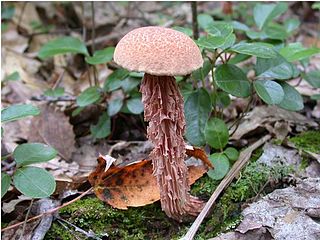
Aureoboletus russellii, commonly known as the Russell's bolete, or jagged-stemmed bolete, is a species of bolete fungus in the family Boletaceae. An edible species, it is found in Asia and eastern North America, where it grows in a mycorrhizal association with oak, hemlock, and pine trees. Fruit bodies of the fungus are characterized by their coarsely shaggy stem. The yellow-brown to reddish-brown caps are initially velvety, but become cracked into patches with age.

Xerocomus illudens is a species of bolete fungus in the family Boletaceae. Described as new to science in 1898, it is found in Asia and North America, where it grows in a mycorrhizal association with oak.

Sclerodermatineae is a suborder of the fungal order Boletales. Circumscribed in 2002 by mycologists Manfred Binder and Andreas Bresinsky, it contains nine genera and about 80 species. The suborder contains a diverse assemblage fruit body morphologies, including boletes, gasteroid forms, earthstars, and puffballs. Most species are ectomycorrhizal, although the ecological role of some species is not known with certainty. The suborder is thought to have originated in the late Cretaceous (145–66 Ma) in Asia and North America, and the major genera diversified around the mid Cenozoic (66–0 Ma).

Leccinellum albellum is a species of bolete fungus in the family Boletaceae. Originally described by Charles Horton Peck as a species of Boletus, and, after 1945, usually considered a species of Leccinum, it was transferred to the newly created genus Leccinellum in 2003. The bolete was reported from a Mexican beech forest in Hidalgo, Mexico in 2010.
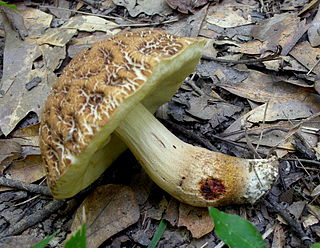
Leccinellum crocipodium is a species of bolete fungus in the family Boletaceae. Fruitbodies contain a benzotropolone pigment called crocipodin.

Retiboletus ornatipes, commonly known as the ornate-stalked bolete or goldstalk, is a species of bolete fungus in the family Boletaceae. Originally named Boletus ornatipes by American mycologist Charles Horton Peck in 1878, it was transferred to Retiboletus in 2002.
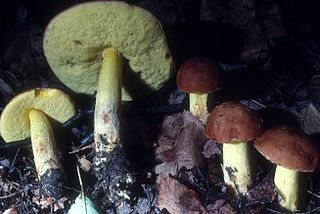
Hemileccinum subglabripes is a fungus of the family Boletaceae native to North America. It was first described by Charles Horton Peck in 1887 as Boletus subglabripes. In 2015 it was transferred to Hemileccinum based on DNA evidence.

Caloboletus firmus is a bolete fungus native to North America. Until 2014, it was known as Boletus firmus. Recent changes in the phylogenetic framework of the family Boletaceae prompted the transfer of this species, along with several other related boletes, including Caloboletus calopus, to the genus Caloboletus. It was first described scientifically in 1874 by American botanist Charles Christopher Frost from specimens collected in New England.
Butyriboletus peckii is a fungus of the genus Butyriboletus native to eastern North America. It was first described by Charles Christopher Frost in 1878. Until 2014, it was known as Boletus peckii. Recent changes in the phylogenetic framework of the Boletaceae prompted the transfer of this species, along with several other related boletes, including Caloboletus calopus, to the genus Caloboletus. In 2015, Kuan Zhao and colleagues published analysis that demonstrated that the bolete belongs to Butyriboletus, closely related to Butyriboletus pulchriceps.

Suillus punctipes, commonly known as the spicy suillus, is a bolete fungus in the family Suillaceae.
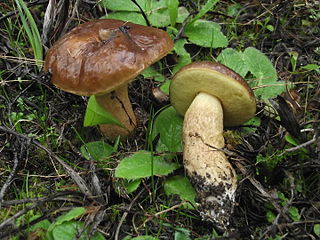
Leccinellum corsicum is a species of bolete fungus in the family Boletaceae. It grows in mycorrhizal symbiosis exclusively with rockroses in Mediterranean Europe and North Africa. The fungus was originally described as new to science in 1896 by French mycologist Léon Louis Rolland as a species of Boletus. Andreas Bresinsky and Manfred Binder transferred it to the newly circumscribed genus Leccinellum in 2003.
Caloboletus panniformis is a bolete fungus native to Honshu island in Japan, where it grows under conifers in subalpine regions. Until 2014, it was known as Boletus panniformis. Recent changes in the phylogenetic framework of the family Boletaceae prompted the transfer of this species, along with several other related boletes, including Caloboletus calopus, to the genus Caloboletus. It was first described scientifically in 2013 by Japanese botanist Haruki Takahashi and colleagues.
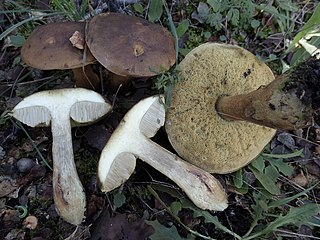
Leccinellum lepidum is a species of bolete in the family Boletaceae. Originally described as Boletus lepidus in 1965, the fungus has gone through controversial taxonomic treatments over the years and was subsequently transferred to genus Krombholziella in 1985, to genus Leccinum in 1990, and to genus Leccinellum in 2003. It is the sister-species of Leccinellum corsicum, with which it had been erroneously synonymised by some authors in the past.

















